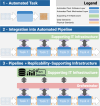Engineering biology and automation-Replicability as a design principle
- PMID: 39734660
- PMCID: PMC11681252
- DOI: 10.1049/enb2.12035
Engineering biology and automation-Replicability as a design principle
Abstract
Applications in engineering biology increasingly share the need to run operations on very large numbers of biological samples. This is a direct consequence of the application of good engineering practices, the limited predictive power of current computational models and the desire to investigate very large design spaces in order to solve the hard, important problems the discipline promises to solve. Automation has been proposed as a key component for running large numbers of operations on biological samples. This is because it is strongly associated with higher throughput, and with higher replicability (thanks to the reduction of human input). The authors focus on replicability and make the point that, far from being an additional burden for automation efforts, replicability should be considered central to the design of the automated pipelines processing biological samples at scale-as trialled in biofoundries. There cannot be successful automation without effective error control. Design principles for an IT infrastructure that supports replicability are presented. Finally, the authors conclude with some perspectives regarding the evolution of automation in engineering biology. In particular, they speculate that the integration of hardware and software will show rapid progress, and offer users a degree of control and abstraction of the robotic infrastructure on a level significantly greater than experienced today.
Keywords: automation; bioinformatics; synthetic biology.
© 2024 The Author(s). Engineering Biology published by John Wiley & Sons Ltd on behalf of The Institution of Engineering and Technology.
Conflict of interest statement
Neither co‐Editor‐in‐Chief was involved in the handling of the article or its peer review process. An Associate Editor has taken full responsibility of the editorial process for the article. [Correction added on 22 Jul 2024, after first online publication. The conflict of interest section is updated.]
Figures



Similar articles
-
An engineering biology approach to automated workflow and biodesign.Synth Biol (Oxf). 2024 Jun 15;9(1):ysae009. doi: 10.1093/synbio/ysae009. eCollection 2024. Synth Biol (Oxf). 2024. PMID: 38939829 Free PMC article. Review.
-
Accelerating strain engineering in biofuel research via build and test automation of synthetic biology.Curr Opin Biotechnol. 2021 Feb;67:88-98. doi: 10.1016/j.copbio.2021.01.010. Epub 2021 Jan 25. Curr Opin Biotechnol. 2021. PMID: 33508635 Review.
-
Engineering genetic circuits: advancements in genetic design automation tools and standards for synthetic biology.Curr Opin Microbiol. 2022 Aug;68:102155. doi: 10.1016/j.mib.2022.102155. Epub 2022 May 16. Curr Opin Microbiol. 2022. PMID: 35588683 Review.
-
Supercharging engineering biology with automation.Eng Biol. 2024 Dec 23;8(4):69-73. doi: 10.1049/enb2.12036. eCollection 2024 Dec. Eng Biol. 2024. PMID: 39734659 Free PMC article.
-
Setting Up an Automated Biomanufacturing Laboratory.Methods Mol Biol. 2021;2229:137-155. doi: 10.1007/978-1-0716-1032-9_5. Methods Mol Biol. 2021. PMID: 33405219
Cited by
-
Mechanobiology in Action: Biomaterials, Devices, and the Cellular Machinery of Force Sensing.Biomolecules. 2025 Jun 10;15(6):848. doi: 10.3390/biom15060848. Biomolecules. 2025. PMID: 40563488 Free PMC article. Review.
References
-
- OECD : Artificial Intelligence in Science: Challenges, Opportunities and the Future of Research’ (Organisation for Economic Co‐operation and Development (2023)
-
- Safeguarding the Bioeconomy. National Academies Press; (2020) - PubMed
-
- Cambridge Dictionary | English Dictionary. Translations & Thesaurus, https://dictionary.cambridge.org/. Accessed March 2024
Publication types
LinkOut - more resources
Full Text Sources

